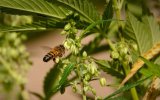Entomologists first found the bee with two fathers and no mother
Entomologists have described 10 bees from one colony, which turned out to be two or three fathers and one mother, described in Biology Letters. Another specimen from the same colony of the mother was not at all, only two fathers.
Upstairs
According to the authors, this is the first known case when a hymenopterous insect was the result of a merger of the paternal genome.
News Scientists said, as the ants are hunting for the heads of enemies
Scientists said, as the ants are hunting for the heads of enemies
Many social insects the uterus to the founding of the colony mates with several males and stores the sperm for the rest of my life. In honey bees the Queen mates with at least 10 males, and after the founding of the colony she constantly lays eggs, some of which remain unfertilized. Of them hatch into male drones, while fertilized eggs the worker bees. But insects can develop gynandromorphous — an anomaly in which the body of one individual are present in the genotype the outward signs of male and female. The bees gynandromorphous develops as a result of the connection of the fertilized egg and sperm from one male.
Entomologists from the University of Sydney under the leadership of Benjamin Oldroyd (Oldroyd Benjamin) found in one of the colonies of Italian bees (Apis mellifera ligustica) 11 individuals with probable gynandromorphous. The mother of these bees had a Queen, which mated with males and founded a colony in a natural way. Researchers have studied outward signs gynandromorph bees and their genotype.
The results showed that 10 of the 11 bees do combined female and male external characteristics and genotype. Some of them were of the unusual color of the abdomen, five bees were the sexual organs, which are characteristic of bees, three of them, they were abnormally developed, almost like the uterus.News American bees caught in fields with hemp
American bees caught in fields with hemp
Two bees were partly female, partly male reproductive organs. With regard to genotype, the two individuals had three fathers, others — two.
But the most unusual genotype was female, which did not have the maternal nuclear genome, only two of his father’s. Externally, it looked like the working bee, and from others it differed only unusual coloration of the abdomen. But her genotype is likely a result of the merger of two paternal nuclear genomes, which according to the authors of the study, is the first known case from Hymenoptera.